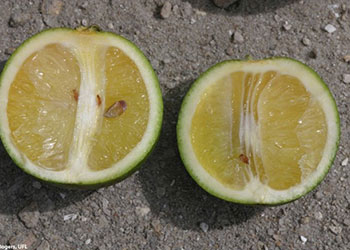PLANT PEST

M.E. Rogers, UFL, idtools.org.
Huanglongbing and vectors
Exotic to Australia
Features: A bacterial disease that causes yellowing, blotchy mottling, and unseasonal leaf flushing, leaf drop, and dieback on citrus; and the insects that spread it.
Where it's from: Asia, Africa, Oceania, and the Americas.
How it spreads: Importation of infected plant material or infected vector insects called citrus psyllids.
At risk: Commercial varieties of citrus, especially oranges, mandarins and tangelos as well as related ornamentals.
This pest is listed on both the National Priority Plant Pests and the National Priority List of Exotic Environmental Pests, Weeds and Diseases as it has the potential for significant plant industry/agriculture impacts and may also cause significant damage to our environment and social amenity.
Keep it out
Huanglongbing (yellow dragon disease), previously known as citrus greening, is one of the worst diseases of citrus trees in the world. It is caused by the bacterial disease Candidatus Liberibacter asiaticus, which spreads through the tree canopy, causing decline and then death of the tree. The only way to rid citrus orchards and home gardens of the disease is to replace infected trees, so the cost of an outbreak is huge.
It infects citrus species as well as curry leaf (Bergera koenigii) and the common garden plant, orange jasmine (Murraya).
If Huanglongbing established in Australia, most backyard citrus trees would not survive for more than a few years, and our citrus growers and their communities would face great hardship.
The disease could make it to Australia through the importation of infected plants or budwood, cuttings and rootstock.
Since Huanglongbing is found in neighbouring countries to our north, the islands of Torres Strait provide a potential pathway for it. Huanglongbing could also be brought in by two kinds of citrus psyllids that carry the disease, so there are biosecurity measures in place to keep them out as well.
Importing goods
To keep Huanglongbing out of Australia, never ignore Australia’s strict biosecurity rules.
Import shipments may need to be treated and certified, so before you import, check our Biosecurity Import Conditions system (BICON).
What to look for
- Blotchy yellowing of leaves that is not symmetrical on both sides.
- Deformed, small, sour and bitter fruit.
Also look for the exotic psyllids that carry the disease, the Asian citrus psyllid and the African citrus psyllid. Psyllids:
- are small flying insects, about 3-4 mm long
- look a bit like aphids but they will jump readily when disturbed
- feed on new growth in groups in a head-down, tail up position.
- as nymphs and galls they sit on leaves.
Any psyllid found on citrus should be reported, as there are no psyllids found on citrus in Australia.


Where to look
Orange, mandarin and tangelo are known to be worst affected, whilst grapefruit and lemons have moderate susceptibility. Limes are the least susceptible to the disease.
Importers
Importation of infested plants or plant material is the most likely way that huanglongbing and the exotic psyllids carrying it could make their way to Australia.
Growers and home gardeners
- Keep watch for sick citrus trees with deformed, sour and bitter fruit.
- Any psyllid on citrus should be reported.
- In well-managed orchards, look out for a yellowing that spreads slowly over the tree and through an orchard as well as lopsided small fruit with dark seeds.
- Also watch for diseased ornamental plants including Murraya.


What to do
If you think you’ve found a plant with Huanglongbing or seen a citrus psyllid:
- take a photo
- do not disturb the pest (this may be as simple as closing the doors on a shipping container or containing the infected plant or psyllid in a plastic bag or container)
- collect a sample, if possible to do so without disturbing the insect or infected material.
